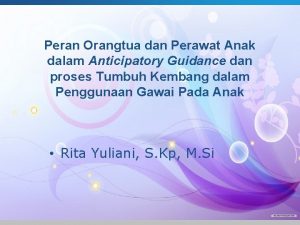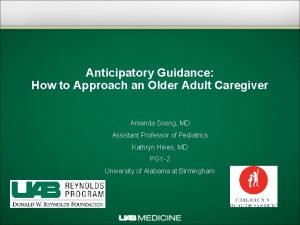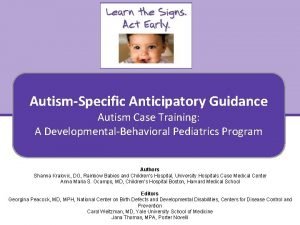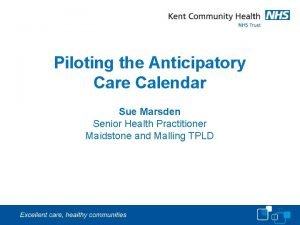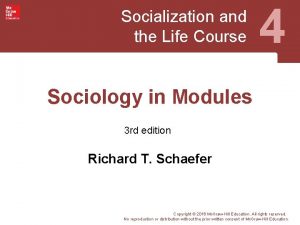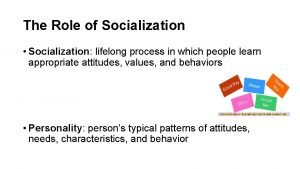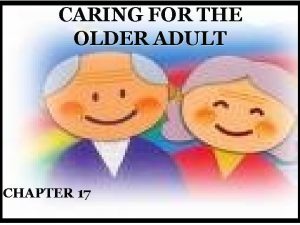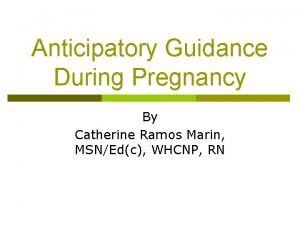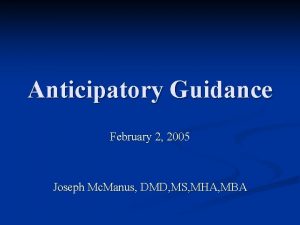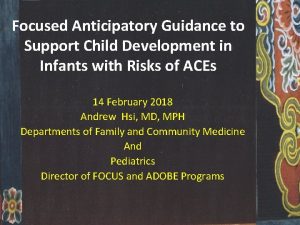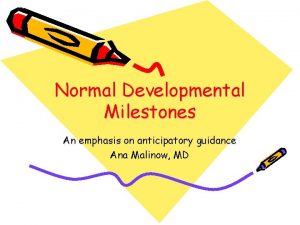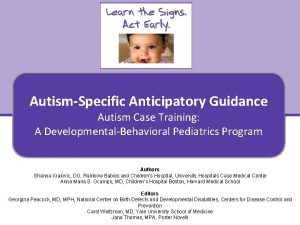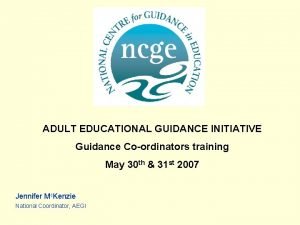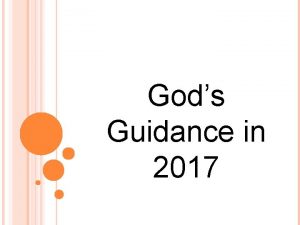Anticipatory Guidance How to Approach an Older Adult



















- Slides: 19

Anticipatory Guidance: How to Approach an Older Adult Caregiver Amanda Soong, MD Assistant Professor of Pediatrics Kathryn Hines, MD PGY-2 University of Alabama at Birmingham

Objectives § Discuss Anticipatory Guidance and its role in the well child check up. § Address potential knowledge gaps more likely to be encountered in an older caregiver. § Discuss tips on how to provide anticipatory guidance in a manner respectful to the caregiver.

Anticipatory Guidance § Anticipatory Guidance “consists of the information that clinicians give families about what they should expect in their child’s development, what they should do to promote this development, and the benefits of these healthy lifestyles and practices. ”¹ 1. From Nelson and et al. , Effectiveness of anticipatory guidance: recent developments

Does it Work? § In an era of increasing scrutiny of evidence of effectiveness of our practices studies have been performed looking at the impact of anticipatory guidance (AG). § Analysis of available studies showed that injury prevention and home literacy interventions are supported by the best evidence.

AG topic Behavior Outcome Child & Family Outcome Parental knowledge about child dev. Improved parental knowledge No change in child’s development Parent- child interaction Higher quality interaction Improved child’s vocal behavior Infant temperament Helped parenting skill Not studied Infant sleep habits Better infant sleep Reduced parental stress, improved parent confidence Discipline Increased use of time out Not studied TV viewing No change Not studied Injury Prevention Increased seat belt use, safe water temp, smoke alarms, outlet covers. No change in use of bike helmet, child proofing Decreased falls, accidents, MVA injuries, but no impact on ER visits. Firearms in home No impact Not studied Reading at home Increased reading, # of books in home Improved expressive and receptive language dev. Adapted from Nelson and et al. , Effectiveness of anticipatory guidance: recent developments

Anticipatory Guidance There a ton of topics that can be covered at each visit. There are several ways to determine what you want to make sure to address: Use the interaction with the caregiver to guide you on what topic might be most important (time out, bed routine, internet safety). Allow families to fill out standardized questionnaires designed to identify areas of concern. Most pediatricians will also develop their own list of the important topics they want to touch upon during each visit.

How Do Pediatricians Do? Studies have shown that Pediatricians have room for improvement in the area of Anticipatory Guidance.

How Can We Improve? § Standardized visit sheet sand computerized visits make it easier to address anticipatory guidance topics.

Giving AG to an Older Caregiver Providing AG to a young parent who is nervous and wants direction is one thing, providing the information to an older caregiver, be it a grandparent, or a mother of 10 is another situation entirely. During the visit, it is important that you address areas you feel are important, while respecting the experience of the caregiver you are addressing.

Giving AG to an Older Caregiver What are some methods to overcome challenges while giving AG? Try using unbiased evidence to state your case as the pediatrician: in the case of a smoker, tell GM you are glad she is healthy, but often smoking does cause health problems, and it can cause illness in infants around smoke. For sleeping on the back, can tell GM with we used to think sleeping on the tummy was best until a large study showed that sleeping on the tummy can cause SIDs. Reassure her that babies are usually able to keep from choking if they spit up while on their back. Can always state that you both want the best for the child. You simply want to make sure the child is as safe as possible.

Giving AG to an Older Caregiver § At the end of the day, it is your job to provide information to the caregiver about safe choices. It is the caretaker’s responsibility to use that information. You cannot control what they decide to do with the information you provide.

Our Study § Surveyed local grandparent and older adult child caregiver support groups § Survey included 15 multiple-choice questions regarding anticipatory guidance topics such as feeding/eating, sleeping, and other safety issues. § Following survey completion, the question answers were discussed with the group. § These results may help guide your topics of conversation when giving AG to an older caregiver.

Questions Most Often Answered Correctly § 100% of those surveyed knew that the safest place for an infant to sleep was a crib. § 100% of those surveyed knew that crackers were a safe food for 18 month olds to eat. § 79. 2% of those surveyed thought that babies should be weaned from bottles at age 9 -12 months. § 75% of those surveyed thought that the an infant can start drinking whole milk at the age of 12 months.

Questions Most Often Answered Incorrectly § 8. 33% of those surveyed knew the AAP recommendation of TV time for children above the age of 2. (2 hours or less per day) § 16. 7% of those surveyed knew the AAP recommendation of TV time for age 0 -2. (No TV) § 16. 7% of those surveyed knew the temperature at which to set their hot water heater to avoid serious burns. (120 degrees) § 25% of those surveyed knew the correct age for infants to start eating baby food. (4 -6 months) § 25% of those surveyed knew the correct age at which infants could start drinking water. (small amount at 4 months) § 29. 2% of those surveyed correctly believed that walkers did not help babies learn how to walk. (meaning 70 % thought walkers help babies learn how to walk)

Additional Areas for Concern Proper position for baby to sleep 50% correctly answered “on its back” Less than 50% seemed to follow this recommendation. Some of the respondents told the surveyors that they knew this was the “right” answer, but did not believe it. Many concerns associated with babies sleeping on back Crib safety 60% of participants thought bumpers were safe and needed in cribs Many participants thought not having bumpers was unsafe. Books as safe toys Only 33% thought books were safe toys for 18 month olds. As evidence has shown, AG to encourage books/reading is effective. Walkers 70% of participants thought walkers helped babies learn to walk. Not addressed in this study, but technology (texting, social websites, internet) should also be discussed when appropriate.

Providing Anticipatory Guidance § Acknowledge their grandparent status. § Acknowledge that, at one time, their method of parenting may have been the recommended method. § Explain why the new method is recommended. § Try to not become frustrated or angry if challenged. § Follow general guidelines for providing anticipatory guidance. § For general tips about AG and some difficult subjects go to : § http: //www. healthychildren. org/English/Pages/default. aspx

Providing Anticipatory Guidance General Tips: Focus on important details. Personalize the information when possible. Use the positive sense (“You should do this” not “You should not do that”) Spend adequate time giving instruction. If using handouts, provide effective, “easy to see, ” printed materials Use sharp contrast between text and background Use font size 16 -18 1 -inch margins Make tables easy to follow

Conclusions Our study shows that there are several anticipatory guidance topics in which older adult caregivers are lacking knowledge. Spend time talking about sleeping position, crib safety, reading to children, and using walkers. Be ready to provide anticipatory guidance to older adults You both are acting in the child’s best interest Their way may have been the right way one time Explain why doctors’ recommendations have changed over the years.

Sources Quick Guide to Health Literacy and Older Adults. U. S. Department of Health and Human Services. www. health. gov/communication/literacy/olderadults/literacy. htm Quick Guide to Health Literacy. U. S. Department of Health and Human Services. www. health. gov/communication/literacy/quickguide/ Effectiveness of anticipatory guidance: recent developments. Nelson C, Wissone, L. and Cheng, T. Current Opinions in Pediatrics. 15: 630 -635. Bright Futures Another great source of information about Anticipatory Guidance is Connected Kids from the AAP. The PDF can be accessed at Connected Kids
 Life is older than the trees
Life is older than the trees Leaflet anticipatory guidance
Leaflet anticipatory guidance Anticipatory guidance for adults
Anticipatory guidance for adults Anticipatory guidance for autism
Anticipatory guidance for autism What is anticipatory set
What is anticipatory set Incisal guidance definition
Incisal guidance definition Developing guidance skills direct and indirect guidance
Developing guidance skills direct and indirect guidance Anticipatory care definition
Anticipatory care definition Example of anticipatory socialization
Example of anticipatory socialization Anticipatory socialization def
Anticipatory socialization def What is anticipatory bail
What is anticipatory bail Types of socialization
Types of socialization Sue marsden
Sue marsden Define anticipatory set
Define anticipatory set Anticipatory socialization
Anticipatory socialization Braden kay
Braden kay Anticipatory set ideas
Anticipatory set ideas Socialization examples
Socialization examples Anticipatory set
Anticipatory set Mental health and older adults
Mental health and older adults

